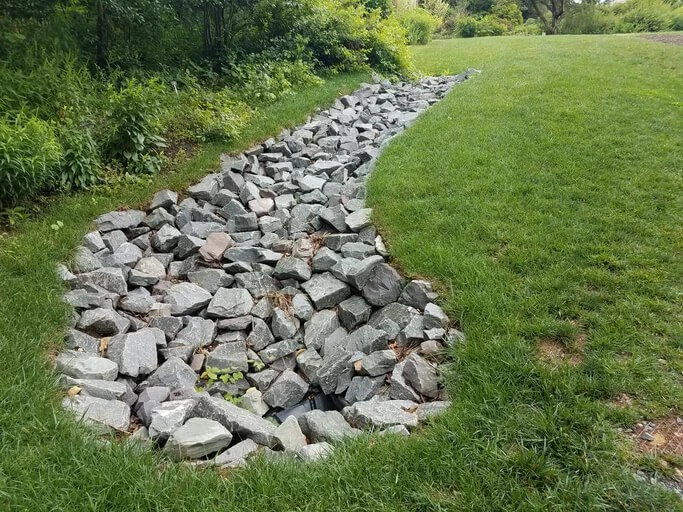At New Life Rockeries, we know lawn drainage is an important part of the functionality of your yard. Washington State sees an average of almost 40 inches of rain per year. This large number can result in a soggy lawn if you don’t have the proper backyard drainage.
To avoid letting your beautiful lawn turn into a swamp, there are several landscaping hacks that you can use in your outdoor design.
Landscaping is generally thought of as purely aesthetic. However, this doesn’t have to be the case! Your landscape can also be used for convenience and functionality while still beautifying your yard.
Adequate drainage is such a vital part of the functionality of your home. Good lawn drainage throughout your landscape will divert rainwater, preventing your yard from becoming soggy.
Before we get into landscaping options for diverting water accumulation, let’s first look into what causes poor lawn drainage.
What Causes Poor Outdoor Drainage?
Water takes a long time to be absorbed into soil. Because of this, you might suffer from poor yard drainage in your backyard.
If you have clay or other close particle soil, you likely need to install a drainage system to avoid waterlogging your backyard. Soils like these aren’t good with lots of water and become waterlogged if neglected.
Other factors also contribute to poor drainage. Things like the incline of your yard and the efficiency of your already existing drainage systems play their part too.
Regardless of why you have a backyard drainage problem, here are a couple of good reasons why you should have it fixed right away.
Why Is Outdoor Drainage So Important?
Good landscaping that diverts water buildup, is vital in maintaining not only your yard but also your house.
Poor backyard drainage will result in damage to your yard and possibly even your house. Neglecting to divert water from your backyard landscape can present a number of serious problems that cost a lot of money to remedy.
To avoid lawn damage due to drainage issues, contact a landscaping professional as soon as you notice the problem. Water can damage your yard and home in more than a few ways, so it is a good idea to have the problem fixed as soon as you notice it.
Landscaping For Water Drainage 4 Ideas
There are more than a few ways to creatively adding proper drainage throughout your backyard.
If you want to have your yard landscaped for drainage, there are more solutions than simply adding a grate drain.
Below are just a couple of examples of landscaping for drainage and how it can be both effective and beautiful.
Create a rain garden
Rain gardens — as the name suggests, are gardens designed with rainfall and backyard drainage in mind.
The number of designs is limitless when it comes to designing a rain garden. Most rain gardens utilize native plants that thrive in wet conditions. These plants, rocks, and other rain garden elements serve to absorb excess rainfall to prevent your lawn from becoming soggy.
Create a rock river
Rock rivers also come in various designs and materials. These beautiful, dry river beds are a creative way to landscape your yard for drainage.
Having a rock river through your backyard is the perfect way to divert water from your landscape and prevent future drainage issues.
Use absorbent elements throughout your landscape
Using absorbent plants, rocks, and mulch throughout your backyard landscape will work wonders. Elements like these help prevent lawn drainage issues by naturally absorbing rainfall.
Having a yard that is prone to water build-up and drainage issues means that you need to design your landscape accordingly.
Use pavers to encourage water drainage
Include pavers that have small gaps to allow for water drainage is also an excellent way to divert water from your backyard landscape.
Small gap pavers can look extremely aesthetic in a backyard landscape and are a subtle way to prepare your lawn for adequate drainage.
Do some looking online to get an idea of what kind of pavers you’d like to have in your yard and what’s available to you.
Hire A Professional Landscape Drainage Expert
Here at New Life Rockeries, we employ only the most skilled landscaping experts for our team. It is our vision to help homeowners in Washington State achieve the outdoor aesthetic of their dreams.
We want to help you make your backyard both beautiful and functional. We understand that many homeowners in the PNW suffer from water drainage issues in their landscape due to heavy rainfall. We want to meet your landscaping needs and help you find the best backyard drainage landscape for your home.
Contact our team of landscaping experts today or fill out our quote form if you’d like to receive a custom quote for your landscaping needs.
Our landscaping contractor professionals want to help you get the yard of your dreams so give us a call today or contact us to find out about the services that we offer and how we can help you with your lawn drainage issue.

